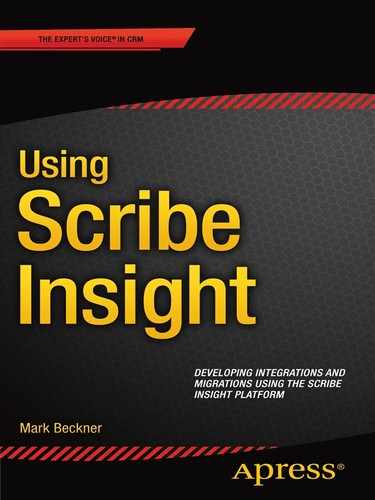Introduction
I have used Scribe on a wide variety of projects. From this work, I’ve found a number of ways to work with the platform that would have saved me a tremendous amount of time if I had known them from the beginning. My goal is to share what I know about it with the hope that this saves you time and frustration while you acquire the skills required.
The first chapter deals with installation and configuration. Like most wizard based installations, if everything goes well you can have Scribe up and running in a matter of minutes. However, after installing Scribe dozens of times in as many environments, I’ve found that failure free installations are rare. I’ve tried to capture and relate the key items you’ll need to know for a successful installation. I’ve also tried to document the issues that you are most likely to run into during your installation and configuration.
In Chapters 2 and 3, I’ve documented everything I believe is essential to developing Scribe DTS packages. The basics outlined here form a foundation for creating production ready solutions, as outlined in later chapters. Unfortunately, many Scribe developers stop their learning once they have acquired these basic skills. The outcome is that they have working solutions that perform poorly, take substantial time to develop, and are too complex to maintain and extend. My hope is that these chapters introduce these fundamental concepts in a clear way, and that you take these concepts and immediately build on them with the information outlined in later chapters.
Chapter 4 introduces the essence of advanced, professional Scribe development; this is the ability to develop integration code in all technologies that are available to you. Instead of developing everything within Scribe, for example, you should be utilizing SQL code for the pre-processing of data. With some simple shifts in where code and mapping lie, you can create solutions that are scalable and easier to develop and maintain. Your key take away from this chapter should be that you must be creative in how you implement your solutions and where you develop your mappings.
The deployment of Scribe packages is generally an afterthought for developers. However, as chapter five outlines, planning how you will be deploying and scheduling your packages will have direct impacts on how you develop your solutions and how your solutions perform. You will want to factor in distributed models with MSMQ limited result sets.
Chapter 6 details the use of adapters, publishers, and queues - all essential components of any advanced solution. There are a variety of ways to connect to data sources and targets, and experimenting with adapters and adapter settings will be important to determine what will work in each scenario. You will find that two connections may act very differently; an ODBC connection to SQL may open up options that a standard Microsoft SQL adapter won’t allow for (such as timeouts and better functionality with pre- and post-SQL execution). You’ll see how publishers can simplify your development and improve performance over creating similar patterns in DTS packages. You’ll also learn more about incorporating MSMQ into your solutions.
Patterns that allow for multi-threaded and better performing solutions are outlined in Chapter 7. You’ll find that small record sets can be processed using any type of architecture, even running straight out of the Workbench. However, larger record sets will require some thought and design in order to process successfully. The use of MSMQ will be essential to any solution that must process large batches of records, and you will want to incorporate this technology into your development before you develop any solution that will be used in a production setting.
The final discussions covered in Chapter 8 deal with administration and troubleshooting solutions. There are a variety of ways to monitor and debug your solutions, but there is no simple way to set breakpoints or walk through code. You’ll need to be smart about how you develop your solutions so that you can more easily test and monitor them.
In the end, my hope is that I’ve documented everything you need to know in order to be successful with your own Scribe development.
—Mark Beckner
November, 2015
